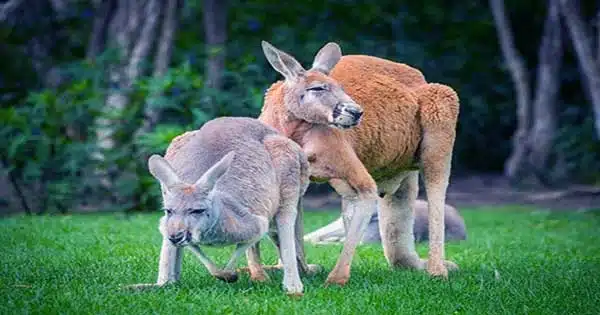According to new research, mammal evolution has been turned on its head, with marsupials being the most advanced mammals.
Scientists have debunked the long-held belief that marsupials are more basic than placentals by estimating how the common ancestor of mammals reproduced and matured.
Marsupials have long been thought to constitute an intermediate step in evolution between egg-laying and placental animals, because they give birth to very underdeveloped offspring that are comparable to placental embryos.
However, a fresh study has indicated that the ancestor of both groups was more similar to placentals than to marsupials, implying that marsupials have changed their reproduction strategy more than placentals.
The study, which was published in the journal Current Biology, examined 22 species of living mammals at various phases of development. The research team was able to reconstruct the alterations to these species’ skulls during this early stage thanks to micro-CT scans of 165 specimens.

They approximated the evolution of the common ancestor of marsupials and placentals using this data, compared it to both groups and determined which had the most similarities.
According to the research leader at the museum and senior author of the paper Professor Anjali Goswami, “Using this big comparative data set generated from the museum’s historical collections, we have been able to flip what we know about mammal evolution on its head.”
Using a massive collection of micro-CT scans of marsupial and placental specimens ranging from embryos to adults, the researchers analyzed how the form of their skull changes during development and recreated how their ancestor would have developed. This demonstrated that marsupials had evolved more from their origin than placentals.
“For a long time, people have treated marsupials as ‘lesser mammals,'” Anjali adds, referring to the intermediate stage between placental animals and egg-layers. “It turns out that marsupials are the ones who are far more evolved from the ancestral form.”
“As members of the placental mammals, we have a tendency to believe that ours is the group to which evolution is directed, but that is not how evolution works.”
Marsupial and placental mammals evolve: All living mammals are classified into three groups placental mammals, marsupials, and monotremes. These are easily identified by their reproduction mechanisms.
The placental mammals are the most numerous group, accounting for around 95% of all living mammals, including humans.
Marsupials also give birth to live young, but their gestation time is quite brief, thus the offspring are severely underdeveloped and must be cared for by a parent in a pouch.
Monotremes are the smallest of the three categories and are egg-laying mammals. There are just five living species in two families: platypus and echidnas.
It is believed that all living animals descended from an egg-laying common ancestor who lived around 180 million years ago. Therians, which include marsupials and placental mammals, are considered to have diverged very soon after, around 160 million years ago.
It was formerly considered that the live delivery of an undeveloped youngster, as in modern marsupials, was the natural intermediate stage as therians evolved away from young being born from an egg. This study, however, discovered that this is not the case.
“What we could clearly show is that the marsupial way of developing is the one that’s changed the most from the ancestor of marsupials and placentals,” Anjali adds.
“Marsupials do not reproduce in a stage between mammalian species that lay eggs and those that carry a placenta. Just that marsupials have developed in a very distinct manner of development.
Why do marsupials produce underdeveloped offspring?
Placental mammals are born with fully developed four limbs and heads that grow in size as the animal grows older. The gestation duration varies according to body size, however in African elephants it can last up to 22 months.
Marshupials, on the other hand, are born in an embryonic form. The red kangaroo, for example, gives birth to a kid the size of a jellybean just a month after conception and nurses its young for up to six months.
Marsupials give birth to underdeveloped offspring: Placental mammals are born with fully developed four limbs and heads that grow in size as the animal grows older. The gestation duration varies according to body size, however in African elephants it can last up to 22 months.
Marshupials, on the other hand, are born in an embryonic form. The red kangaroo, for example, gives birth to a kid the size of a jellybean just a month after conception and nurses its young for up to six months.
These newborns’ hindlimbs and skulls have not fully formed, but their forelimbs and mouth bones are better developed. The animal has all it needs to crawl through its mother’s fur and suckle from the milk-giving teats, but not much else. Many marsupials have a pouch that protects the developing young during this vulnerable stage.
However, it is still unclear why marsupials evolved this reproductive approach.
“It has been suggested that the marsupial strategy is better if you live in an area with a lot of environmental instability,” Anjali explains. “Because platental mammals have long gestation periods, if an animal’s resources run out, both mother and offspring will most likely die because it’s all internal.”
“With a marsupial, it’s a much lower risk strategy because the mother can easily abandon them at a very early developmental stage, so the mother can at least survive and try again later.”
While Australia is home to around two-thirds of all surviving marsupials, the first marsupials are thought to have originated in North America. They spread down via South America, finally making their way to Australia via Antarctica via land connections.
Despite this, several placental mammals lived in South America during this time period but did not appear to make the trek.
“One theory is that marsupials were better prepared to make this journey due to their more flexible reproductive system,” Anjali explains.
“Marsupials may be able to cope better with less stable environmental situations if development is stretched out and made more external to the mother.” But this is a wild guess and a theory that must be tested.”
















